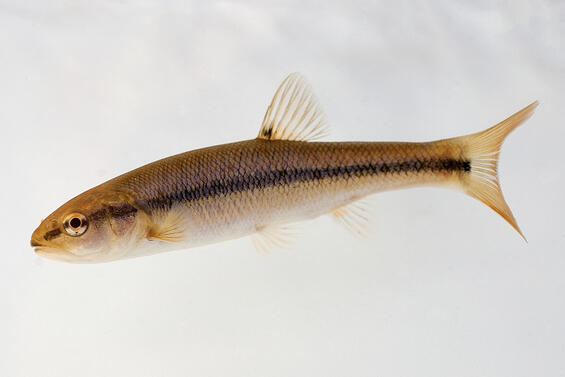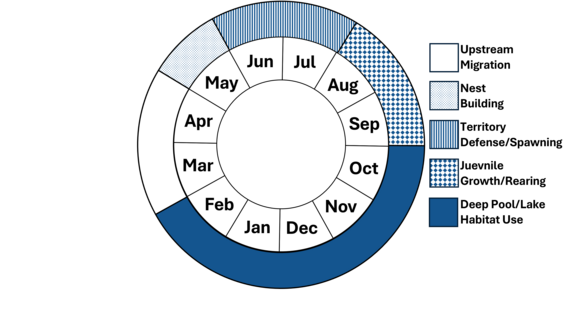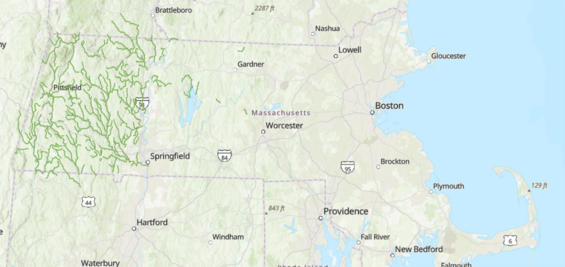- Scientific name: Semotilus atromaculatus
- Species of Greatest Conservation Need (MA State Wildlife Action Plan)
Description

Creek chub (Semotilus atromaculatus)
The creek chub can readily be identified by a distinctive, small spot near the anterior base of the dorsal fin and a large terminal mouth that reaches past the front of the eye. This species often has a small fleshy barbel located in a grove behind their upper jaw. Adults from Massachusetts are usually 100-127mm (4-5 in) in length, but larger individuals have been caught at 136 mm (6.5 in).
While coloration varies slightly depending on the water body, juvenile creek chub has a black lateral band along an olive-silver side that extends from the snout to the caudal base. Breeding males darken dorsally and have a yellow to rosy coloration along the body, orange fins, and blue along the side of the head. During the breeding season, they have 6-12 large tubercles (projections) along their head that are used for territory defense.
Life cycle and behavior

Breeding adults gather on gravel runs in rivers and streams during springtime, where males first build a small depression in the gravel for eggs. During spawning, eggs are deposited and fertilized, covered with a layer of gravel, and guarded by the male until they hatch. Following hatch, individuals often form a school and slowly expand their territory downstream or to connecting tributaries. This species is a generalist feeder that consumes a wide range of aquatic insect larvae and pupae, fishes, and mollusks. It actively forages at a variety of water depths and is most active at sunset. Creek chub are often important diet items for multiple fish and bird species and can provide new feeding opportunities for these individuals during spawning movements.
Population status
The population status of this species is unknown but is captured during standard fish surveys in streams and rivers through its distribution in the state.
Distribution and abundance
This species is common in eastern North America and can be found as far north as southern Canada, and as south as the gulf states. Their range extends as far west as Wyoming and as far east as central Massachusetts. In Massachusetts, creek chub is found in most major river watersheds west of the Connecticut River where they are abundant, especially in smaller to medium-sized rivers and streams. This species is not found East of the Connecticut River in historical and current fish community datasets.

Distribution in Massachusetts. 2000-2025. Based on records in the Natural Heritage Database.
Habitat
This creek chub is considered a fluvial specialist found in riverine habitat class and is present in gently sloping and steep cool and cold water rivers and streams. In this case, the fish mostly uses tributary rivers or streams for spawning and rearing and then adults use larger streams for growth. This species prefers aquatic habitats that contain submergent aquatic vegetation throughout the year and can be found foraging at variable depths. They are often found in slower-moving waters like pools where they can be protected from the current while actively foraging. During the spawning season this species moves upstream into tributaries containing moderate flow, clear water, and rock and gravel for spawning.
Healthy habitats are vital for supporting native wildlife and plants. Explore habitats and learn about conservation and restoration in Massachusetts.
Threats
Seasonal warming associated with climate change is likely affecting the timing of reproduction and habitat usage, and could be negatively impacting this cool water species. Increases in water temperatures and decreases in precipitation during the summertime can reduce available habitat for this species to forage, thermally moderate, and avoid predation. These impacts are exacerbated in streams that are heavily altered by water supply withdrawal and channelization impacting pool habitat refugia and natural stream meandering. Extreme flow events during the spring can impact the availability of spawning habitat by covering gravel and rock with fine sediment, resulting in reduced reproductive outputs. Water withdrawal reduces available summertime rearing and growth habitat. Direct threats such as dams can increase sedimentation and decrease aquatic connectivity, impacting movement to spawning grounds and the quality of these habitats. This species is considered tolerant to pollutants but can be negatively affected by high concentrations entering waterways through impervious surfaces, degraded riparian buffers, and poor wastewater drainage systems.
Conservation
Surveying and monitoring
Efforts to document this species and their abundance are conducted during fish community assessments and have been successful at capturing individuals in historic locations in the western part of the Massachusetts. Survey efforts in the eastern part of the state haven’t yielded any individuals and support the historic range of this species.
Management
Management on this species focuses on river and stream restorations improving habitat connectivity such as dam removal, culvert replacement, and reconnecting streams to their floodplains. These actions help remediate the effects of 300 years of channelization in Massachusetts and increase habitat connectivity and quality of spawning tributaries. These actions also increase habitats like deep pools and tributary junctions that are used for summer and winter refugia during low water or adverse water temperatures.
Research needs
A better understanding of the movements of this species could help update their range in the state and identify important habitat connectivity supporting it. Understanding how river and stream restorations impact spawning grounds and deep pool refugia should be prioritized to protect this species. Specific research on sedimentation processes in areas of urbanization and impervious surfaces could help protect and manage important gravel and rocky spawning grounds necessary for successful reproduction.
References
Hartel, K.E., Halliwell, D.B., Launer, A.E. Inland Fishes of Massachusetts. Lincoln, MA: Massachusetts Audubon Society, 2002.
Page, L.M., Burr, B.M. Peterson Field Guide to Freshwater Fishes of North America North of Mexico. Boston, MA: Houghton Mifflin Harcourt Publishing Company, 2011.
Contact
| Date published: | April 15, 2025 |
|---|